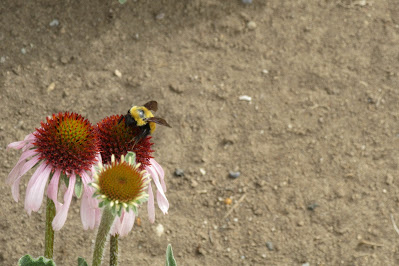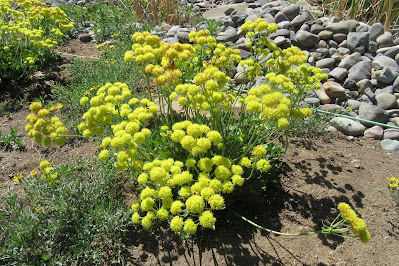 |
| Golden Northern Bumble Bee (Bombus fervidus): nectaring on garden onion |
The
third week in June is National Pollinator Week (https://www.pollinator.org/pollinator-week).
The
word ‘pollinator’ conjures up images of Honey Bees for many people. But the world of pollinators is far more
complex. Our Garden Pollinators
series features some of the many interesting pollinators seen in Western Colorado
gardens. For more on pollinators in
general – and tips for attracting pollinators to your garden – see: https://mothernaturesmontrosegarden.blogspot.com/2020/06/life-friendly-gardening-planning-for.html
 |
| Golden Northern Bumble Bee (Bombus fervidus): love native Penstemons |
One
of the busiest pollinators currently in Mother Nature’s Montrose Garden is the
Golden Northern Bumble Bee. This large,
bright yellow bee is hard to miss. You
may have seen it in your own garden – or out in the wild. Its range covers much of North America, with
the exclusion of much of the southern United States, Alaska, and the northern
parts of Canada. It can be seen in the wild, particularly in grasslands, as
well as in cities and farmland.
The
Golden Northern Bumble Bee was first identified by the Danish zoologist Johan
Christian Fabricius in 1798. [1] Bombus
fervidus is quite similar to Bombus californicus, which has an
overlapping range in the western U.S. Like all Bumble Bees, the species includes males
(drones) and two types of females: queens and worker females.
 |
| Golden Northern Bumble Bee (Bombus fervidus): characteristics |
The
Golden Northern Bumble Bee is a large bee, about ½ inch
long for drones and workers and slightly more (over 3/4 inch) for the larger
queens. One’s first impression is of a large,
very hairy, yellow Bumble Bee. As seen
above, the first four sections of the abdomen are yellow while the terminal
segments are black. The thorax is also
mostly yellow, while the face and legs are black (below). A black band is present between the base of
wings. The underside of the body is also
mostly black in females, but may contain more yellow in males. For more pictures of this species see
reference 2.
 |
| Golden Northern Bumble Bee (Bombus fervidus): identification |
A
new Queen mates once with a male drone in fall; then she overwinters by hibernating
in the ground. Queens emerge as the weather warms in spring and forage for pollen
and nectar (they need energy) and a place to start their nest. Nests may be either above- or below-ground
(more common). Leaving areas of your yard undisturbed is a great way to
encourage nesting in your garden. Nests
are made of grass and dung. The nest site is usually within about 150 ft. of
flower resources.
After
creating her nest, a Queen collects pollen, which she uses to create food for
her initial brood. The honey she makes is stored in special wax compartments –
the ‘honey pots’ – in the nest. The nest is composed of individual cells and the
Queen lays an egg in each cell. This
initial brood has up to 10 individuals. When the eggs hatch, the larvae feed on honey
until they metamorphose into adults. Metamorphosis
takes about 15 to 25 days. The emerging
adults are the smaller, female worker bees (below).
 |
| Golden Northern Bumble Bee (Bombus fervidus): female worker |
 |
| Golden Northern Bumble Bee (Bombus fervidus):Queen |
The
first generation of workers provide all the food needed for the next generation
of offspring, as well as for the Queen. From this point on, the Queen just focuses
on laying eggs. The workers must work very hard; in fact, some work so tirelessly
that their lifespan is shortened to a month or less. [3] Some workers expand
the nest and keep it tidy. But the workers primarily gather pollen to feed the
developing brood. They also chew pollen and mix it with their saliva to make honey.
[1] Each generation will be slightly larger than the preceding generation, due
to increasing food resources.
 |
| Golden Northern Bumble Bee (Bombus fervidus): Queen |
The
Queen is the only female that can produce female offspring (which only develop
from fertilized eggs). Later in the
season, the Queen also lays unfertilized eggs; these develop into males
(drones). Also late in the season, she lays eggs destined to become new Queens.
These become larger than other females in the nest. Workers can also can lay
unfertilized eggs, but these often don’t develop. For more on the Bumble Bee life cycle see
reference 4.
 |
| Golden Northern Bumble Bee (Bombus fervidus): great pollinator |
Because
they are such hard workers, Golden Northern Bumble Bees
are excellent pollinators. Click on
the videos below to see how rapidly they work:
Bombus
fervidus can be seen
foraging whenever the day is warm. They are busy from early morning until evening
in our garden. And they visit a great
many flower species. They have long tongues, allowing them to access nectar in
tubular-shaped flowers. And they don’t hesitate to climb right into a
Penstemon flower. But they nectar at a wide range of types of flowers (below. They tend to favor plants with many small
flowers in our garden: the milkweeds, lilacs, spiraeas, onions, mints, etc. But they really love the penstemons!
 |
| Golden Northern Bumble Bee (Bombus fervidus): on Apache Plume |
 |
| Golden Northern Bumble Bee (Bombus fervidus): on Narrowleaf Coneflower |
 |
| Golden Northern Bumble Bee (Bombus fervidus): on Garden Lilac |
 |
| Golden Northern Bumble Bee (Bombus fervidus): on Nettle-leaf Agastache |
The
Golden Northern Bumble Bee is a wonderful pollinator to have in your garden. It
is easy to attract, as long as you have plenty of floral resources from early
spring through fall. The Bumble Bees are
fascinating to observe – children of all ages enjoy watching them (including us
elders).
Like
many Bumble Bees, Golden Northern numbers appear to be decreasing. Part of this
decline is almost certainly due to loss of habitat. Providing food and a place for Bumble Bees to
raise their young is a simple way to be a good citizen. It will also guarantee more
garden seeds for next year!
So,
plant some native plants and the Bumbles will come. Then upload your photos to
Bumble Bee Watch: Bumble Bee Watch.
 |
| Golden Northern Bumble Bee (Bombus fervidus): on Palmer's Penstamon |
___________
- Bombus fervidus -
Wikipedia
- Bombus
fervidus - -- Discover Life
- ADW: Bombus
fervidus: INFORMATION (animaldiversity.org)
- Life
Cycle and Biology – Bumble Bees of Wisconsin – UW–Madison
We welcome your comments (below). You can also send your questions to: monaturesmontrosegarden@gmail.com

















